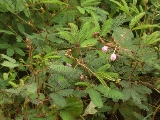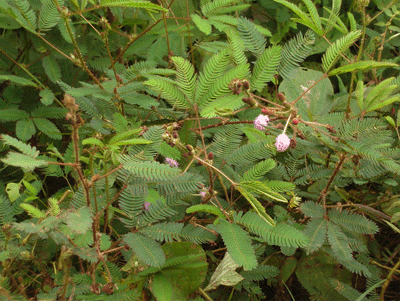
Thigmonasty
Encyclopedia

Plant
Plants are living organisms belonging to the kingdom Plantae. Precise definitions of the kingdom vary, but as the term is used here, plants include familiar organisms such as trees, flowers, herbs, bushes, grasses, vines, ferns, mosses, and green algae. The group is also called green plants or...
or fungus
Fungus
A fungus is a member of a large group of eukaryotic organisms that includes microorganisms such as yeasts and molds , as well as the more familiar mushrooms. These organisms are classified as a kingdom, Fungi, which is separate from plants, animals, and bacteria...
to touch or vibration. It differs from thigmotropism
Thigmotropism
Thigmotropism is a movement in which an organism moves or grows in response to touch or contact stimuli. The prefix thigmo- θιγμος comes from the Greek for "touch". Usually thigmotropism occurs when plants grow around a surface, such as a wall, pot, or trellis. Climbing plants, such as vines,...
in that it is independent of the direction of the stimulus. For example, tendrils from a climbing plant are thigmotropic because they twine around any support they touch. However, the shutting of a venus fly trap is thigmonastic. The time scale of thigmonastic responses tends to be faster than thigmotropism because thigmonasty depends on turgor and bistable
Bistability
Bistability is a fundamental phenomenon in nature. Something that is bistable can be resting in either of two states. These rest states need not be symmetric with respect to stored energy...
mechanisms rather than growth or cell division. Certain dramatic examples of rapid plant movement
Rapid plant movement
Rapid plant movement encompasses movement in plant structures occurring over a very short period of time, usually under one second. For example, the Venus Flytrap closes its trap in about 100 milliseconds. The Dogwood Bunchberry's flower opens its petals and fires pollen in less than 0.5 milliseconds...
such as the sudden drooping of Mimosa pudica
Mimosa pudica
Mimosa pudica , is a creeping annual or perennial herb often grown for its curiosity value: the compound leaves fold inward and droop when touched or shaken, re-opening minutes later...
are fast enough to observe without time lapse photography.
The most spectacular display of thigmonasty occurs in the Venus Flytrap
Venus Flytrap
The Venus Flytrap , Dionaea muscipula, is a carnivorous plant that catches and digests animal prey—mostly insects and arachnids. Its trapping structure is formed by the terminal portion of each of the plant's leaves and is triggered by tiny hairs on their inner surfaces...
(Dionaea muscipula). When an insect lands on a trap formed by two curved lobes of a single leaf, the trap rapidly switches from an open to a closed configuration. Investigators have observed an action potential
Action potential
In physiology, an action potential is a short-lasting event in which the electrical membrane potential of a cell rapidly rises and falls, following a consistent trajectory. Action potentials occur in several types of animal cells, called excitable cells, which include neurons, muscle cells, and...
and changes in leaf turgor that accompany the reflex
Reflex
A reflex action, also known as a reflex, is an involuntary and nearly instantaneous movement in response to a stimulus. A true reflex is a behavior which is mediated via the reflex arc; this does not apply to casual uses of the term 'reflex'.-See also:...
, which is due to the rapid elongation of individual cells, commonly termed acid growth
Acid growth
Acid growth refers to the ability of plant cells and plant cell walls to elongate or expand quickly at low pH. This form of growth does not involve an increase in cell number. During acid growth, plant cells enlarge rapidly because the cell walls are made more extensible by expansin, a...
although it does not involve cell division
Cell division
Cell division is the process by which a parent cell divides into two or more daughter cells . Cell division is usually a small segment of a larger cell cycle. This type of cell division in eukaryotes is known as mitosis, and leaves the daughter cell capable of dividing again. The corresponding sort...
.
Mimosa pudica is a plant with compound leaves that has attracted detailed investigation. It appears that contact or injury causes leaflet
Leaflet
A leaflet in botany is a part of a compound leaf. A leaflet may resemble an entire leaf, but it is not borne on a stem as a leaf is, but rather on a vein of the whole leaf. Compound leaves are common in many plant families...
deformation that in turn triggers an action potential. The action potential travels through the plant until it reaches a pulvinus
Pulvinus
A pulvinus is a joint-like thickening at the base of a plant leaf or leaflet that facilitates growth-independent movement. It consists of a core of vascular tissue within a flexible, bulky cylinder of thin-walled parenchyma cells...
at the base of the leaflet
Leaflet
A leaflet in botany is a part of a compound leaf. A leaflet may resemble an entire leaf, but it is not borne on a stem as a leaf is, but rather on a vein of the whole leaf. Compound leaves are common in many plant families...
or petiole
Petiole (botany)
In botany, the petiole is the stalk attaching the leaf blade to the stem. The petiole usually has the same internal structure as the stem. Outgrowths appearing on each side of the petiole are called stipules. Leaves lacking a petiole are called sessile, or clasping when they partly surround the...
.
The pulvinus is a motor structure consisting of a rod of sclerenchyma surrounded by collenchyma. The structure is widespread in the legume family. In its extended position, the cell
Cell (biology)
The cell is the basic structural and functional unit of all known living organisms. It is the smallest unit of life that is classified as a living thing, and is often called the building block of life. The Alberts text discusses how the "cellular building blocks" move to shape developing embryos....
s of the entire collenchyma are distended with water. On receiving the action potential signal, the cells in the lower half of the pulvinus respond by expelling potassium
Potassium
Potassium is the chemical element with the symbol K and atomic number 19. Elemental potassium is a soft silvery-white alkali metal that oxidizes rapidly in air and is very reactive with water, generating sufficient heat to ignite the hydrogen emitted in the reaction.Potassium and sodium are...
and chlorine
Chlorine
Chlorine is the chemical element with atomic number 17 and symbol Cl. It is the second lightest halogen, found in the periodic table in group 17. The element forms diatomic molecules under standard conditions, called dichlorine...
ions and taking up of calcium
Calcium
Calcium is the chemical element with the symbol Ca and atomic number 20. It has an atomic mass of 40.078 amu. Calcium is a soft gray alkaline earth metal, and is the fifth-most-abundant element by mass in the Earth's crust...
ions. This results in an osmotic gradient
Osmosis
Osmosis is the movement of solvent molecules through a selectively permeable membrane into a region of higher solute concentration, aiming to equalize the solute concentrations on the two sides...
that draws water out of the affected cells. The lower pulvinus cells temporarily shrink due to water loss. This forces the entire structure to curve down in the manner of a fan
Fan (implement)
A hand-held fan is an implement used to induce an airflow for the purpose of cooling or refreshing oneself. Any broad, flat surface waved back-and-forth will create a small airflow and therefore can be considered a rudimentary fan...
. In this contracted position, the pulvinus no longer functions as a support and the petiole droops. In addition, botanists have discovered signalling molecule
Molecule
A molecule is an electrically neutral group of at least two atoms held together by covalent chemical bonds. Molecules are distinguished from ions by their electrical charge...
s called turgorins, that help mediate the loss of turgor. In species with the fastest response time, vacuoles are believed to provide temporary, high speed storage for calcium ions.

Pea
A pea is most commonly the small spherical seed or the seed-pod of the pod fruit Pisum sativum. Each pod contains several peas. Peapods are botanically a fruit, since they contain seeds developed from the ovary of a flower. However, peas are considered to be a vegetable in cooking...
vine closes its leaves around a support in a thigmonastic gesture. Thigmonasty is especially prevalent in the mimosa genus. Catclaw Brier, a prairie mimosa, native to North America, shuts its leaves on contact. Since the plant is attractive to herbivore
Herbivore
Herbivores are organisms that are anatomically and physiologically adapted to eat plant-based foods. Herbivory is a form of consumption in which an organism principally eats autotrophs such as plants, algae and photosynthesizing bacteria. More generally, organisms that feed on autotrophs in...
s, its behavior provides protection against grazing
Plant defense against herbivory
Plant defense against herbivory or host-plant resistance describes a range of adaptations evolved by plants which improve their survival and reproduction by reducing the impact of herbivores. Plants use several strategies to defend against damage caused by herbivores...
.
Sensitive leaves also occur in plants of the sorrel
Sorrel
Common sorrel or garden sorrel , often simply called sorrel, is a perennial herb that is cultivated as a garden herb or leaf vegetable...
family. Examples include wood sorrel, a pretty, woodland spring flower; Biophytum sensitivum, a palmlike plant from Africa and star fruit
Carambola
Carambola, also known as starfruit, is the fruit of Averrhoa carambola, a species of tree native to the Philippines, Indonesia, Malaysia, India, Bangladesh and Sri Lanka. The fruit is a popular food throughout Southeast Asia, the South Pacific and parts of East Asia...
, named for its oddly structured fruit.
A different form of thigmonasty than leaf closure occurs in thistle
Thistle
Thistle is the common name of a group of flowering plants characterised by leaves with sharp prickles on the margins, mostly in the family Asteraceae. Prickles often occur all over the plant – on surfaces such as those of the stem and flat parts of leaves. These are an adaptation that protects the...
. When an insect lands on a flower, the anthers shrink and rebound. The effect is to load the insect with pollen. Turgor change acts on the specialized, highly elastic cell walls of the anthers to produce the effect. Similar behavior has been reported in black-eyed susan
Black-eyed Susan
Black-eyed Susan may refer to one of several things:Flowers* Rudbeckia hirta, a member of the sunflower tribe of the large family Asteraceae* A number of other members of the genus Rudbeckia* Hibiscus trionum in the family Malvaceae...
. .
Some fungi exhibit trap closure similar to the venus fly trap. Mycologists have discovered action potentials in fungi but it is not currently known if they are related to thigmonasty.

